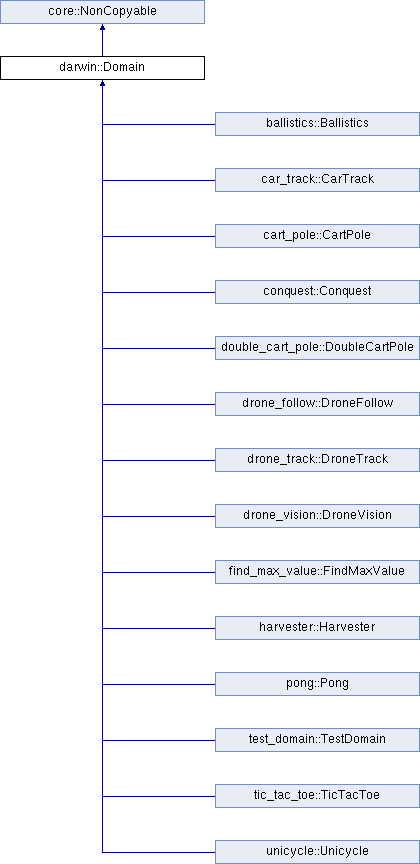Interface to a domain implementation. More...
#include <darwin.h>

Public Member Functions | |
| virtual size_t | inputs () const =0 |
| Number of inputs to a Brain. | |
| virtual size_t | outputs () const =0 |
| Number of outputs from a Brain. | |
| virtual bool | evaluatePopulation (Population *population) const =0 |
| Assigns fitness values to every genotype. More... | |
| virtual unique_ptr< core::PropertySet > | calibrateGenotype ([[maybe_unused]] const Genotype *genotype) const |
| Optional: additional fitness metrics (normally not used in the population evaluation, ie a test set) | |
Detailed Description
Interface to a domain implementation.
A domain defines a problem to be solved, including the environment for plugging in brains from a population (see Brain) and the rules for evaluating the fitness of the corresponding genotypes.
The brains are treated as black boxes with a domain-specific, fixed number of inputs and outputs (ie once the domain is configured the values for inputs and outputs will not change during a particular evolution run)
- See also
- Population
- DomainFactory
Member Function Documentation
◆ evaluatePopulation()
|
pure virtual |
Assigns fitness values to every genotype.
Having a good fitness function is a key part of evolutionary algorithms:
- Perhaps obvious, the fitness value should accurately estimate the quality of a particular solution
- A "smooth" distribution is preferable since it provides a gradient which can guide the incremental search in the solutions space. (ex. if most fitness values are 1.0 or 0.0 it's hard to know which genotypes are good candidates for reproduction)
- Returns
trueif the evolution goal was reached
Implemented in unicycle::Unicycle, double_cart_pole::DoubleCartPole, cart_pole::CartPole, tic_tac_toe::TicTacToe, drone_follow::DroneFollow, ballistics::Ballistics, car_track::CarTrack, drone_track::DroneTrack, drone_vision::DroneVision, conquest::Conquest, find_max_value::FindMaxValue, pong::Pong, harvester::Harvester, and test_domain::TestDomain.
The documentation for this class was generated from the following file:
- C:/Users/lemo/work/darwin/core/darwin.h
 1.8.14
1.8.14